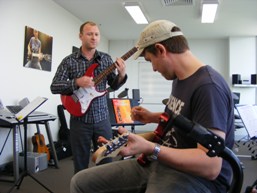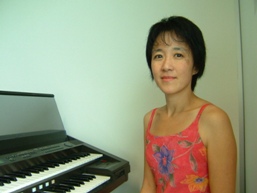Welcome to Vol.2 of the ‘Yamaha Music Teacher Interview Relay’.
Over four issues, we will publish interviews of some of the teachers in the newly opened Yamaha Music School in Carnegie. In these interviews, the teachers discuss their passion for music – both in teaching and in their own lives.
–Please tell us your experiences before becoming a Yamaha teacher and how you came to be a Yamaha teacher.
I started playing the guitar when I was a teenager. Starting at about 16 or 17, I began performing in gigs and working in the music industry. I still perform 3 or 4 times a week on a regular basis.
In 2009 I had interviews with Yamaha senior staff Robyn St George and Rose Longmore, and started my career as a Yamaha teacher midway through last year.
–How do you find teaching in a group environment? What is the most significant difference you find between teaching group lessons and individual lessons?
The fantastic thing about teaching in a group environment is that the children respond to their learning experiences as a team. Not only do they respond to the teacher and the music, they also respond to their peers.
When they look around them in class, seeing fellow guitarists makes them feel like they are in a rock band! They also play along with a backing tape which includes drums, bass and other instruments. This really brings out that rock band atmosphere. They quickly become friends and I believe that the fun they have with each other contributes greatly to their accomplishments. I believe this is a very unique aspect when teaching in a group environment as compared with individual lessons.

–What techniques do you use to draw responses from the group?
We use a variety of imitative and rhythmic call-and-response type activities in order to have students respond altogether. This helps the learning process and makes efficient use of lesson time.
–Do you teach all age groups? If so, do you think this course is effective across the board?
I teach all age groups. There are three streams for the guitar program: Junior, Teen and Adult.While the course is beautifully designed and well paced, I personally believe that it is also up to me as the teacher to vary my style of teaching according to the age and ability of the students. This is why the course definitely works for people of all ages – the students are grouped with others close in age who learn in a similar style to each other.
–Do you have any tips to learn the guitar?
There are no magic tricks in learning music or learning the guitar. The method I believe in, which is an integral part of the Yamaha method, encourages “Repetition”. You have to play a phrase over and over in order to develop a strong aural and muscle memory of the phrase. The classes move fairly quickly, so students must also stay focussed and listen carefully. I believe that repetition and keen listening are the best tips for learning the guitar.
.JPG)
–Finally, do you have some advice for people who want to start learning the guitar?
The guitar is a fantastic instrument to learn. It is portable and all it takes is to sling it on your back and take it to school or to rehearsals. It also allows you to play many different styles of music. You can play rock, classical, blues, jazz – almost any genre you can think of sounds great on the guitar!. So it’s a great instrument to learn if you love exploring different styles of music.
—————————————————————————————————————————–
And now, could you quickly introduce Hui-Ling please.
Sure. Hui-Ling teaches the Music Wonderland classes which are for kids aged 3 and a half to 4 and a half years old. All the parents speak very well of her! Her ability to create an atmosphere where adults and children enjoy music together makes her very popular. If I were 4 years old, I would love to learn music with Hui-Ling.





.JPG)


